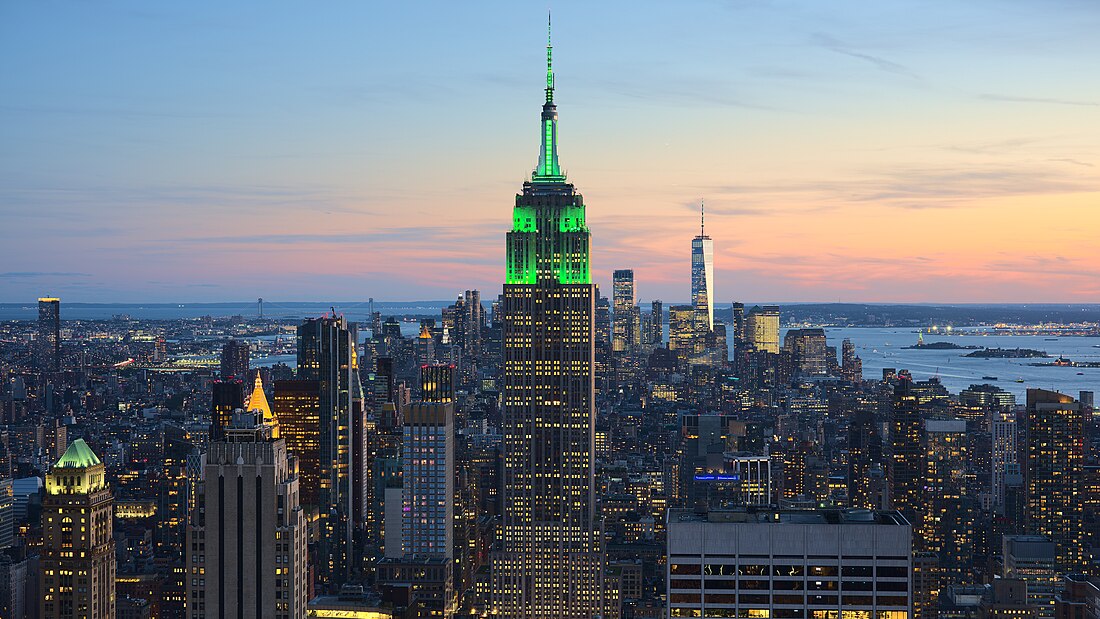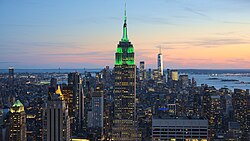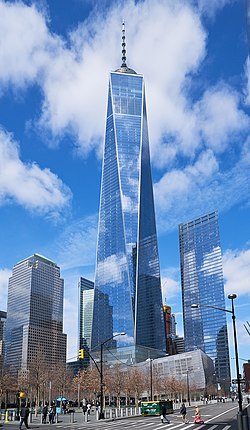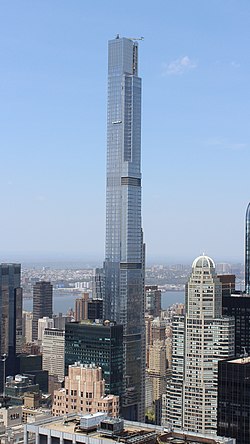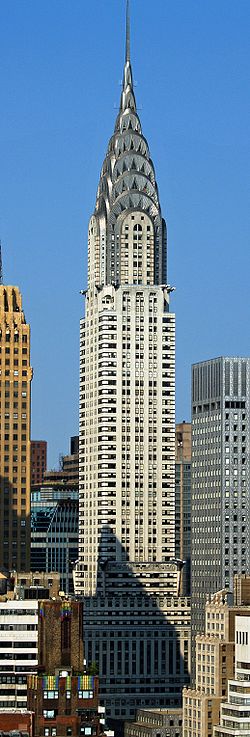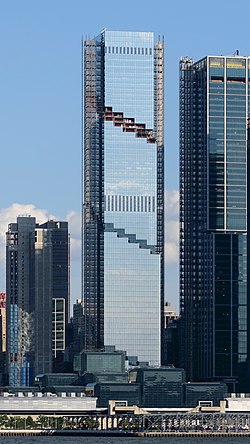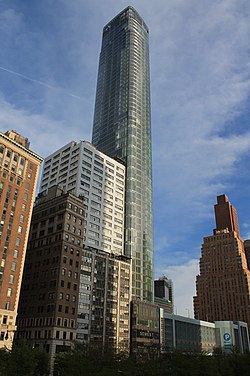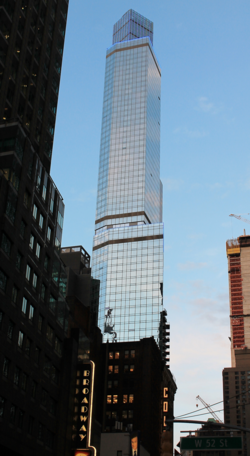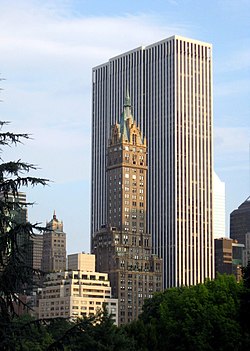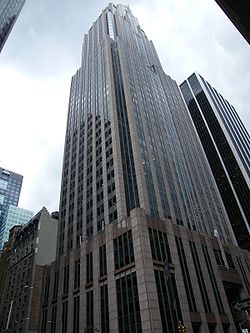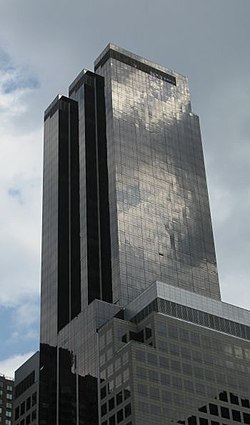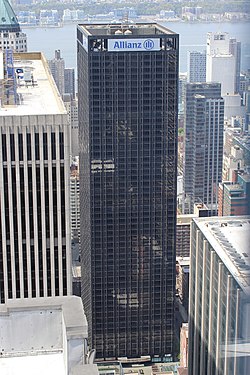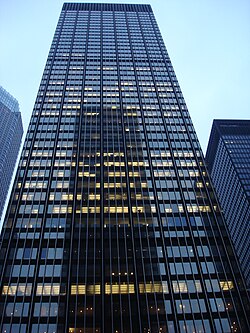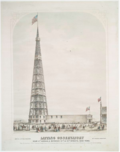Top Qs
Timeline
Chat
Perspective
List of tallest buildings in New York City
From Wikipedia, the free encyclopedia
Remove ads
New York City is the most populous city in the United States, with a metropolitan area population of over 19 million as of 2025. Its skyline is one of the largest in the world, and the largest in the United States, in North America, and in the Western Hemisphere. Throughout the 20th century, New York City's skyline was by far the largest in the world. New York City is home to more than 7,000 completed high-rise buildings of at least 115 feet (35 m),[5] of which at least 102 are taller than 650 feet (198 m). The tallest building in New York is One World Trade Center, which rises 1,776 feet (541 m).[6][7][8] The 104-story[A] skyscraper also stands as the tallest building in the United States, the tallest building in the Western Hemisphere, and the seventh-tallest building in the world.[6][7]
Midtown Manhattan in September 2023 looking north from the Empire State Building's 102nd floor (1,224 feet or 373 meters)
Lower Manhattan, viewed from Jersey City, New Jersey with the World Trade Center complex in the middle
The city is home to many of the earliest skyscrapers, which began to appear towards the end of the 19th century. A major construction boom in the 1920s saw the completion of some of the tallest skyscrapers in the world at the time, including the Chrysler Building in 1930 and the Empire State Building in 1931 in Midtown Manhattan. At 1,250 feet (381 m) and 102-stories, the Empire State Building stood as the tallest building in the world for almost four decades; it remains among the city's most recognizable skyscrapers today.[9] Following a lull in skyscraper development during the 1930s to 1950s, construction steadily returned. The Empire State Building was dethroned as the world's tallest building in 1970, when the 1,368-foot (417 m) North Tower of the original World Trade Center surpassed it.[10] The North Tower, along with its twin the South Tower, held this title only briefly as they were both surpassed by the Willis Tower (then Sears Tower) in Chicago in 1973. The Twin Towers remained the tallest buildings in New York City until they were destroyed in the September 11 attacks in 2001.[11][12]
Starting from the mid-2000s, New York City would undergo an unprecedented skyscraper boom. The new One World Trade Center, part of the redevelopment of the World Trade Center, began construction in 2006 and was completed in 2014. It surpassed the Empire State Building as the city's tallest, and overtook the Willis Tower to become the tallest building in the United States.[7][13] In Midtown Manhattan, a luxury residential boom led to the completion of Central Park Tower, the second-tallest building in the city at 1,550 feet (472 m), with the highest roof of any building outside Asia; 111 West 57th Street, the city's third tallest building and the world's most slender skyscraper at 1,428 feet (435 m), and 432 Park Avenue, the city's fifth tallest building at 1,397 feet (426 m). The tallest office skyscraper in Midtown, One Vanderbilt, is the fourth-tallest building in the city at 1,401 feet (427 m). New York City has the third-most supertall skyscrapers in the world.
The majority of skyscrapers in New York City are concentrated in Midtown and Lower Manhattan, although other neighborhoods of Manhattan and the boroughs of Brooklyn, Queens, and the Bronx are also home to a substantial number of high-rises. A popular misconception holds that the relative lack of skyscrapers between Lower and Midtown Manhattan is due to the depth of the bedrock beneath the two districts.[14][15] Since the 2010s, an increasing number of skyscrapers have been built in Downtown Brooklyn and Long Island City, as well as along the East River in Brooklyn and Queens.
Remove ads
History
Summarize
Perspective
Early skyscrapers

The history of skyscrapers in New York City began with the construction of the Equitable Life, Western Union, and Tribune buildings in the early 1870s. These relatively short early skyscrapers, sometimes referred to as "preskyscrapers" or "protoskyscrapers", included features such as a steel frame and elevators—then-new innovations that were used in the city's later skyscrapers.[16]: 62 Modern skyscraper construction began with the completion of the World Building in 1890; the structure rose to a pinnacle of 349 feet (106 m).[17] Though not the city's first high-rise, it was the first building to surpass the 284-foot (87 m) spire of Trinity Church.[18] The World Building, which stood as the tallest in the city until 1899,[B] was demolished in 1955 to allow for the construction of an expanded entrance to the Brooklyn Bridge.[19] The Park Row Building, at 391 feet (119 m), was the city's tallest building from 1899 to 1908,[20] and the world's tallest office building during the same time span.[21] By 1900, fifteen skyscrapers in New York City exceeded 250 feet (76 m) in height.[16]: 280
New York has played a prominent role in the development of the skyscraper. Since 1890, ten of those built in the city have held the title of world's tallest.[22][C] New York City went through a very early high-rise construction booms from the 1890s through the 1910s.[23] Notable skyscrapers completed during the first boom include the Singer Building, which was the first skyscraper in New York and the second in the world to exceed 492 feet (150 m) in height, and the Met Life Tower, which is the earliest skyscraper to reach 492 feet (150 m) that still stands today. Another notable landmark was the Woolworth Building, the first building in the world to be taller than 656 feet (200 m). All three buildings held the title of the tallest building in New York City and the world at the time.
After a lull in skyscraper construction in the mid-1910s, a second boom occurred from the mid-1920s to the early 1930s.[23] Skyscrapers reached greater heights in Lower Manhattan and especially in Midtown Manhattan. This period saw the completion of 40 Wall Street, the Chrysler Building, and the Empire State Building, partially driven by increased commercial demand and economic development during the Roaring Twenties and a desire for developers to outdo one another in height.[24] The Chrysler Building was completed in 1930, one year after the onset of the Great Depression; at a height of 1,049 feet (319 m), it became the world's first supertall skyscraper. The Empire State Building was completed one year later. In total, during the early 20th century, 44 skyscrapers over 492 feet (150 m) were built.[25] Many of the buildings during the second boom were built in the Art Deco style.[26]: 7
1930s–1950s

After the early 1930s, skyscraper construction came to a halt for over 20 years owing to economic pressures during the Depression and World War II. Many office skyscrapers in Midtown Manhattan had large amounts of vacant space years after completion.[27] A notable exception to the hiatus was the early modernist 75 Rockefeller Plaza, built as a northern extension to the Rockefeller Center in 1947.[28] Gradually, skyscraper development resumed in the 1950s.[29]: 47, 50
Many new skyscrapers eschewed the Art Deco of the early 20th century and were built adhering to the modernist International Style. This style emphasized function over form, often involving fewer or no setbacks, and glass curtain walls.[29]: 47, 50 The most prominent of these were the Seagram Building and the United Nations Secretariat Building, the latter of which hosts the offices of the United Nations Secretariat, as New York City was chosen as the headquarters for the newly formed United Nations after the war. Other noteworthy skyscrapers built during the era include the Socony–Mobil Building, 660 Fifth Avenue, 1065 Avenue of the Americas, and 2 Broadway.
1960s–1980s

The New York City Zoning Resolution of 1961 incentivized the building of more office skyscrapers in Manhattan.[30] Notable buildings to go up in the 1960s include the octagonal MetLife Building[31] and the General Motors Building.[32] Some early skyscrapers, such as the Singer Building and the City Investing Building, were demolished to make way for new developments.
In 1966, construction began on the World Trade Center complex, including twin supertall skyscrapers measuring 1,368 feet (417 m) and 1,362 feet (415.1 m) in height. Known as the Twin Towers, they reshaped the Lower Manhattan skyline when they topped out in 1970, and over time, became an iconic symbol of New York City.[33] Midtown Manhattan saw increasingly tall skyscrapers like the Citigroup Center and One Penn Plaza in the 1970s; during this decade, the city surpassed 100 skyscrapers above 492 feet (100 m) in height. Another construction surge in the late 1980s increasingly embraced more postmodernist designs, such as CitySpire and 1 Worldwide Plaza.
1990s–present

After the early 1990s, skyscraper development slowed down once more, with the most significant new skyscraper during this lull being 4 Times Square. The 2000s saw the resumption of office skyscraper development, alongside an growing number of residential skyscrapers. The Bank of America Tower and the New York Times Building became the first supertall skyscrapers to be built in the city since the original Twin Towers. The mid-2010s saw an especially large surge in construction, with office and residential structures reaching new heights. While New York City had only two supertall buildings in 2010, that figure has grown to 18 by 2025.
WTC redevelopment
In 2001, the September 11 attacks led to the collapse of the Twin Towers, and the Empire State Building regained the title of the tallest building in the city. The Twin Towers were the tallest buildings ever to have been destroyed. Plans to rebuild the site were soon proposed, and construction began for a new World Trade Center complex in 2004. The centerpiece of the redevelopment, One World Trade Center, was completed in 2014 at a height of 1,776 ft (541.3 m). The height is a symbolic reference to the year of the signing of the United States Declaration of Independence. Upon topping out, the building became the tallest building in the city and the United States. Also part of the complex is 3 World Trade Center, a supertall skyscraper completed in 2018. The site for 2 World Trade Center has been repeatedly delayed; excavation commenced in 2008 on a design from British architect Norman Foster, but works were halted in 2013, with construction only occurring up to street level. The proposal was redesigned by Bjarke Ingels of Bjarke Ingels Group in 2015, featuring a terraced, cantilevering structure. As of 2025, no work has started on the rest of the tower.
Supertall boom and Hudson Yards

A boom in the development of supertall residential skyscrapers began with One57 and 432 Park Avenue, the latter surpassing the height of the Empire State Building to become the tallest building in Midtown Manhattan in 2015. This trend culminated with the completion of 111 West 57th Street and Central Park Tower in the early 2020s, both surpassing 1,400 feet (427 m) in height. These buildings are primarily catered towards the luxury market; their prevalence near the southern side of Central Park has led the area around them to be named "Billionaire's Row".
Two signifiant commercial supertall skyscrapers, both exceeding 1,300 feet (396 m), have topped out in the 2020s: One Vanderbilt, forming a new peak in the skyline around Grand Central Terminal; and 270 Park Avenue, which will serve as the new headquarters of JPMorgan Chase. The skyline of the western side of Midtown Manhattan was also massively transformed with the Hudson Yards development. Built on the eastern side of West Side Yard, Phase I of the development began construction in 2012 and was completed in 2019. Within the development are three supertall skyscrapers: 35 Hudson Yards, 30 Hudson Yards, and The Spiral, alongside several other skyscrapers. Additionally, located near Hudson Yards is One Manhattan West, another supertall skyscraper completed in 2019. Phase II of Hudson Yards is under planning, and could potentially include more supertall buildings and a casino.[34]
Taller residential skyscrapers also arrived at the Upper East Side and Upper West Side areas of Manhattan.[35] 520 Park Avenue became the tallest building on the Upper East Side in 2018,[36] while 200 Amsterdam became the tallest on the Upper West Side in 2021;[37] it will soon be supplanted by 50 West 66th Street, which is topped out.[38]
Beyond Manhattan

Skyscraper development has also increasingly spread beyond Manhattan in the 21st century. Few tall buildings were built in Brooklyn since the completion of the Williamsburgh Savings Bank Tower in 1929, which remained the tallest building in the borough for 80 years. Since the late 2000s, a growing number of residential high-rises have been built in Downtown Brooklyn, which has since formed a significant high-rise skyline of its own.[39] As of 2025, Brooklyn is home to 17 skyscrapers taller than 492 feet (150 m). The tallest, the Brooklyn Tower, was completed in 2022 at 1,066 feet (325 m); it is the first and only supertall skyscraper in the city outside of Manhattan.[40]
The neighbourhood of Long Island City (LIC), in Queens, has also developed a sizeable skyline throughout the 2010s.[41] One Court Square, built in 1990, was the only skyscraper in Queens for over a decade, until the addition of more residential high-rises in the late 2000s; there are now 14 skyscrapers taller than 492 feet (150 m) in the borough. The tallest, The Orchard, was completed in 2024. Residential skyscrapers have also gone up on waterfront of East River in Brooklyn and Queens since the late 2010s, particularly in the Williamsburg, Greenpoint, and Hunters Point neighbourhoods. On a lesser scale, high-rises developments are also becoming more common in the areas of Flushing,[42] Gowanus,[43] Jamaica,[44] and South Bronx.[45]
Although not located in New York City, the neighborhood of Exchange Place in Jersey City has seen a similar boom in tall buildings since the 2000s.[46] More recently, in the 2020s, the area of Journal Square has also seen an influx in skyscrapers.[47]
Remove ads
Cityscape
Tallest buildings
Summarize
Perspective
This list ranks completed and topped out New York City skyscrapers that stand at least 650 feet (198 m) tall based on standard height measurements. This includes spires and architectural details but does not include antenna masts. An equal sign (=) following a rank indicates the same height between two or more buildings. The "Year" column indicates the year in which a building was completed.
Was New York City's tallest building upon completion
Architecturally topped out but not yet completed
Tallest buildings by pinnacle height

This list ranks buildings in New York City based on pinnacle height measurement, which includes antenna masts. Standard architectural height measurement, which excludes non-architectural antennas in building height, is included for comparative purposes. An equal sign (=) following a rank indicates the same height between two or more buildings. The "Year" column indicates the year in which a building was completed.
Tallest buildings in each borough
This lists the tallest building in each borough of New York City based on standard height measurement. The "Year" column indicates the year in which a building was completed.
Remove ads
Tallest under construction or proposed
Summarize
Perspective
Under construction
This lists buildings that are currently under construction in New York City and are expected to rise to a height of at least 650 feet (198 m). Buildings under construction that have already been topped out are included in the table above. The "year" column indicates the expected year of completion. A dash "–" indicates information about the building is unknown or not publicly available. For buildings whose heights have not yet been released by their developers, this table uses a floor count of 50 stories as the cutoff.
On hold
This lists buildings that were previously under construction in New York City that were expected to reach a height of 650 feet (198 ft) where work has stopped.
Approved
This table lists buildings that are approved for construction in New York City and are expected to rise at least 650 feet (198 m) in height. For buildings whose heights have not yet been released by their developers, this table uses a floor count of 50 stories as the cutoff.
Proposed
This table lists buildings that are proposed for construction in New York City and are expected to rise at least 650 feet (198 m) in height. For buildings whose heights have not yet been released by their developers, this table uses a floor count of 50 stories as the cutoff.
Remove ads
Tallest destroyed or demolished
Summarize
Perspective
This table lists buildings in New York City that were destroyed or demolished and at one time stood at least 500 feet (152 m) in height.
Was the world's tallest building upon completion
Remove ads
Timeline of tallest buildings
Summarize
Perspective
This lists buildings that once held the title of tallest building in New York City. Both Trinity Church and the Empire State Building have held the title twice, the latter following the destruction of the World Trade Center in the September 11 attacks. The Empire State Building was surpassed by One World Trade Center in 2012.
Remove ads
Map of tallest buildings
Summarize
Perspective
The map below shows the location of every building taller than 650 feet (198 m) in New York City. Each marker is colored by the decade of the building's completion.
Remove ads
Skylines
See also
- Architecture of New York City
- List of cities with the most skyscrapers
- List of tallest buildings
- List of tallest buildings in the United States
- List of tallest buildings in Albany, New York
- List of tallest buildings in Brooklyn
- List of tallest buildings in Buffalo, New York
- List of tallest buildings in Jersey City
- List of tallest buildings in New Jersey
- List of tallest buildings in Queens
- List of tallest buildings in Rochester, New York
- List of tallest buildings in Upstate New York
Notes
- The building is 104 standard floors tall and most references supply this figure. However, only 94 actual, physically usable, stories are present; see the skyscraper's main article for more details.
- As measured to its tip (or pinnacle). Five other skyscrapers in Manhattan had already surpassed its 309-foot (94 m) architectural height by then, starting with the Manhattan Life Insurance Building in 1894. For more on the different criteria used see List of tallest buildings and structures#Tallest buildings
- This considers only skyscrapers by architectural height. It was not until the completion of the Singer Building in 1908 that a skyscraper surpassed the spire of the tallest building constructed using conventional methods. Only the Chrysler and Empire State Buildings held the title of world's tallest overall structure, the latter of which maintained this title for more than two decades until surpassed by Oklahoma's Griffin Television Tower in 1954.
- Floor counts often vary among sources, this list uses the number most widely reported in reference. Read the FAQ on the talk page for details.
- References typically use the 102 floors figure, however some state a value of 103 floors instead due to the presence of an encircling balcony above the 102nd floor. See Empire State Building#Opening and early years and Empire State Building#Above the 102nd floor for a detailed explanation.
- Prior to 1985, the pinnacle height was 1,472 feet (449 m). This was reduced to the current value when the original antenna was replaced by a shorter one.[273]
- The floor count of the World Building has been disputed. Upon construction, the building was said to contain up to 26 floors, but in recent years the building has been said to contain as few as 16 floors.[361]
Remove ads
References
External links
Wikiwand - on
Seamless Wikipedia browsing. On steroids.
Remove ads
